The C Ration
The
American infantry soldier began WWII with the "combat"
meal known officially as Field Ration, Type C. There were three
individually boxed meals for breakfast, dinner (i.e., lunch), and
supper. Soldiers quickly tired of these meat-and-hash meals because
they were also served in the central mess tents when soldiers rotated
off the front lines and yearned for more variety.
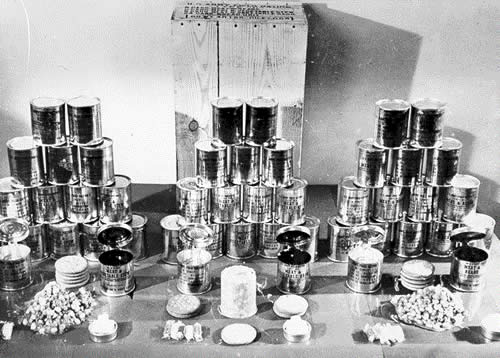
The
first version of the C rations offered a simple menu consisting
of:
Package
of Biscuits
Package of Graham Crackers
Package of Sugar Tablets
Meat Can of Ham (Breakfast), Chicken (Dinner), Turkey (Supper)
Fruit Bar (Breakfast), Caramels (Dinner), Chocolate Bar (Supper)
Powdered Coffee (Breakfast), Bouillon (Dinner), Lemon (Supper)
Piece Chewing Gum
4-Pack Cigarettes
Package of Toilet Tissue
Wooden Spoon
Matches
In
early 1944 specifications for the C rats increased variety by alternating
combinations of the "B," or bread, units, and the "M,"
or meat, units. An accessory pack included nine "good commercial-quality"
cigarettes, water-purification tablets, matches, toilet paper, chewing
gum, and an opener for the meat cans. A soldier's daily ration was
three cans of B units, three cans of M units, and one accessory
pack.
|
M unit varieties
Meat and beans
Meat and vegetable stew
Meat and spaghetti
Ham, egg, and potato
Meat and noodles
Pork and rice
Franks and beans
Pork and beans
Ham and lima beans
Chicken and vegetables
B
unit components
Biscuits
Compressed and premixed cereal
Candy-coated peanuts or raisins
Powdered coffee
Sugar
Powdered lemon or orange juice
Cocoa powder
Hard candies
Jam
Caramels
|
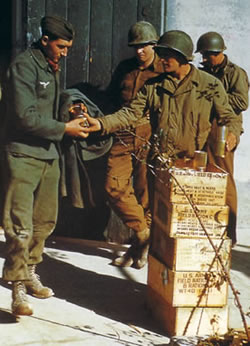 |
C Ration Packaging
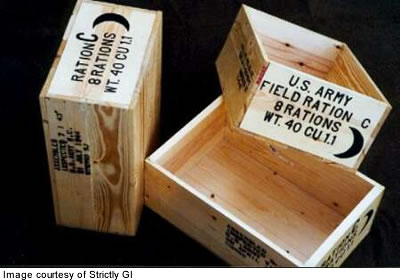
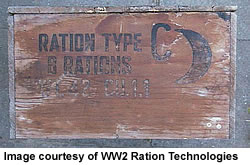 C
rations boxes contained three meals for each of eight men: three
M units and three B units per man per day, for a total of 48 cans. C
rations boxes contained three meals for each of eight men: three
M units and three B units per man per day, for a total of 48 cans.
There
were three distinct versions of C ration box markings. You'll notice
the fresh-looking wooden boxes above, used by re-enactors from Strictly
GI, come close to matching the samples of two types of actual WWII
boxes from the collection of WW2 Ration Technologies. These styles
are different from pre-1944 boxes seen in the first two images on
this page. The early style was specified in C.Q.D. No. 6D, Amendment
2, March 30, 1943, which spelled out the following packaging requirements:
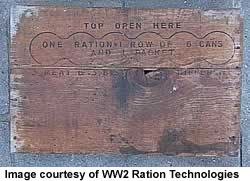 "Unless
otherwise specified two tiers of 24 cans each shall be packed
in nailed, wooden boxes.... The two tiers will be separated by
a chip board pad.... The nailed, wooden box shall have inside
dimensions of 18" x 12" x 7 1/8", with a tolerance
of plus or minus 1/16 of an inch. The ends of the boxes shall
be manufactured of lumber 5/8 of an inch thick.... "Unless
otherwise specified two tiers of 24 cans each shall be packed
in nailed, wooden boxes.... The two tiers will be separated by
a chip board pad.... The nailed, wooden box shall have inside
dimensions of 18" x 12" x 7 1/8", with a tolerance
of plus or minus 1/16 of an inch. The ends of the boxes shall
be manufactured of lumber 5/8 of an inch thick....
All
boxes shall be stenciled or printed on both ends as follows:
U.S.
Army Field Ration C
8 cans Meat and Beans
8 cans Meat and Vegetable Hash
8 cans Meat and Vegetable Stew
24 cans Bread Unit
1.12 cu. ft. Gross ___ lbs.
The
container shall be printed on one side panel as follows:
48
B Units, Ration C (Abbreviation for beverage C, L, or CB)
Contract Number (The contract number shall be given without
the words "Contract Number")
The
directive also specifies the size of the crescent moon symbol (3"
tall, 2" wide, and 7/8" thick at the center of the moon.)
When
the menu expanded to include greater variety of M units in 1944,
the box dimensions grew slightly to 19 1/4" x 12 3/4"
x 7 3/4" while still holding 48 cans. The displacement of the
box was now 1.16 cubic feet, with a gross weight of 40 lbs. ("Ration
Development," Vol. 12, Office of the Quartermaster General)
Gerald
Peterson's example of a vintage wooden box seen here measures 19
5/8" x 12 3/4" x 8" externally.
Later
in the war, C rations were packaged in V1 corrugated fiberboard
containers of the same approximate dimensions and labeling as the
wooden crate, and packed in the same manner. They were usually sleeved
and banded with metal straps. Unfortunately, I have not come across
any photos of the carton, nor has Gerald Peterson of WWII Ration
Technologies been able to find an example.
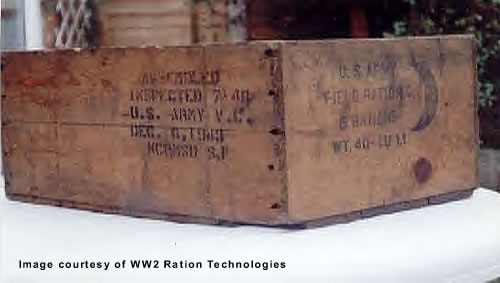
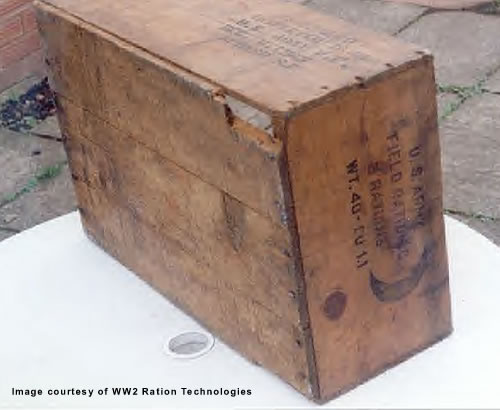
1/35 Scale
C Rations
It
turns out that, product labels to the contrary, there are NO bona
fide C ration cartons or boxes on the market today! However, I include
Plus Models here because their items don't specify 10-in-1. Actually,
as you'll see they don't really specify much of anything.
|
|
|
| Product |
Plus
Model #2: U.S. Field C-Rations Cartons |
Plus
Model #3: U.S. Combat Rations Cartons |
|
Number
of items
|
8
fiberboard cartons |
9
fiberboard cartons. |
| Historical
dimensions |
19
5/8 x 12 3/4 x 8 |
19
5/8 x 12 3/4 x 8 |
| Product
dimensions |
19
x 12 1/2 x 12 |
19
x 12 x 6 1/2 |
| Material
and color |
Light
card stock, more brown in color. |
Light
card stock, fibers visible; color more brown than others. |
| Instructions
|
Yes
(in Czech) |
Yes
(in Czech) |
| Markings |
!MENU
4 U.S. Field C Rations Cartons, Unterbrech Ordrer, Quartrage
lelse, Turnment 2 Slek im Brut
|
Do
not cement
ensemble
has pat coller
2acha. GWA 4151 2G
|
| Comments |
The
only resemblance of this product to a real rations container
is its shape and color.
The
marking "U.S. Field C Rations Cartons" is handprinted.
The rest of the words, even without magnification of my
computer scanner, are nonsensical.
Metal
strapping is represented by a band of broken line that is
printed around the circumference.
|
This
is a very poor product with no resemblance to any real rations
carton other than its shape and the half-moon symbol. |
| Finished
Product |
|
|
| Final
Thoughts |
Avoid
these like the plague. |
No
redeeming value. |
|












